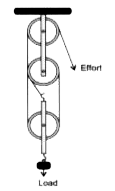Draw a diagram to show how a single pulley can be used so as to have its ideal M.A. = 2.
To solve the problem of how a single pulley can be used to achieve an ideal mechanical advantage (M.A.) of 2, we will follow these steps:
Step 1: Understand the Concept of Mechanical Advantage
Mechanical Advantage (M.A.) is defined as the ratio of load (output force) to effort (input force). For an ideal M.A. of 2, it means that the load should be twice the effort.
Step 2: Draw the Diagram
1. Draw the Pulley: Start by drawing a simple diagram of a single pulley. The pulley should be represented as a circular shape with a groove around its edge.
2. Label the Components:
- Axle: Draw a horizontal line through the center of the pulley to represent the axle.
- Frame: Draw vertical lines on either side of the pulley to represent the frame supporting it.
- Load (L): Below the pulley, draw a downward arrow to represent the load being lifted.
- Effort (E): Above the pulley, draw an upward arrow to represent the effort being applied.
3. Connect the Load and Effort:
- Draw a rope that goes over the pulley. One end of the rope is attached to the load (L) and the other end is where the effort (E) is applied.
Step 3: Analyze the Forces
1. Identify Tension (T): The tension in the rope is the same throughout if we assume the pulley is frictionless. Let the tension in the rope be T.
2. Load and Effort Relationship:
- The load (L) is supported by two segments of the rope, so the total upward force due to tension is 2T (because there are two segments of the rope supporting the load).
- The effort (E) applied is equal to the tension (T) in the rope.
Step 4: Calculate the Mechanical Advantage
Using the formula for Mechanical Advantage:
M.A.=LoadEffort=LE
Substituting the values:
L=2TandE=T
M.A.=2TT=2
Conclusion
The ideal mechanical advantage of the pulley system is 2, meaning that the load is twice the effort applied.
Mechanical Advantage (M.A.) is defined as the ratio of load (output force) to effort (input force). For an ideal M.A. of 2, it means that the load should be twice the effort.
1. Draw the Pulley: Start by drawing a simple diagram of a single pulley. The pulley should be represented as a circular shape with a groove around its edge.
2. Label the Components:
- Axle: Draw a horizontal line through the center of the pulley to represent the axle.
- Frame: Draw vertical lines on either side of the pulley to represent the frame supporting it.
- Load (L): Below the pulley, draw a downward arrow to represent the load being lifted.
- Effort (E): Above the pulley, draw an upward arrow to represent the effort being applied.
3. Connect the Load and Effort:
- Draw a rope that goes over the pulley. One end of the rope is attached to the load (L) and the other end is where the effort (E) is applied.
1. Identify Tension (T): The tension in the rope is the same throughout if we assume the pulley is frictionless. Let the tension in the rope be T.
2. Load and Effort Relationship:
- The load (L) is supported by two segments of the rope, so the total upward force due to tension is 2T (because there are two segments of the rope supporting the load).
- The effort (E) applied is equal to the tension (T) in the rope.
Using the formula for Mechanical Advantage:
M.A.=LoadEffort=LE
L=2TandE=T
M.A.=2TT=2
The ideal mechanical advantage of the pulley system is 2, meaning that the load is twice the effort applied.
Topper's Solved these Questions
Similar Questions
Draw a ray diagram to show how a convex lens can be used as a magnifying glass.
View SolutionDraw a diagram to show how NAND gates can be combined to obtain an OR gate. (Truth table is not required).
View SolutionDraw a neat diagram to show how bimetallic strip is used in a fire alarm system.
View SolutionDraw a diagram to show a block and tackle pulley system having a velocity ratio of 3 marking the direction of load (L), effort (E) and tension (T).

View SolutionWhat is the ideal mechanical advantage of a single fixed pulley ? Can it be used as a force multiplier?
View SolutionDraw a diagram of a combination of three movable pulleys and one fixed pulley to lift up a load. In the diagram, show the directions of load, effort and tension in each strand. Find : (i) the mechanical advantage, (ii) the velocity ratio, and (iii) the efficiency of the combination, in the ideal situation.
View SolutionDraw a diagram to show the energy changes in an oscillating simple pendulum. Indicate in your diagram how the total mechanical energy in it remains constant during the oscillation.
View SolutionIn the laboratory preparation of hydrochloric acid, HCl gas is dissolved in water.
Draw a diagram to show the arrangement used for the absorption of HCI in water.
View SolutionA block and tackle has two pulleys in each block, with the tackle tied to the hook of the lower block and the effort being applied upwards.
(a) draw a neat diagram to show this arrangement and calculate its mechanical advantage.
(b) If the load moves up a distance x, by what distance will the fre end of the string move up ?
View SolutionUse the molecular orbital energy level diagram to show that N2 would be expected to have a triple bond. F2, a single bond and Ne2 , no bond.
View Solution